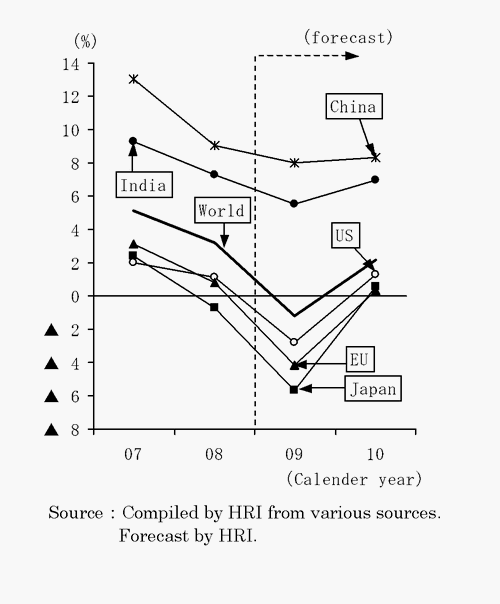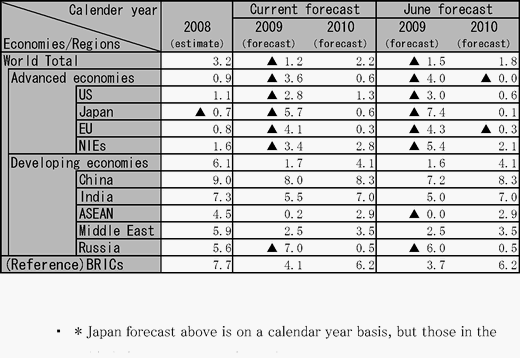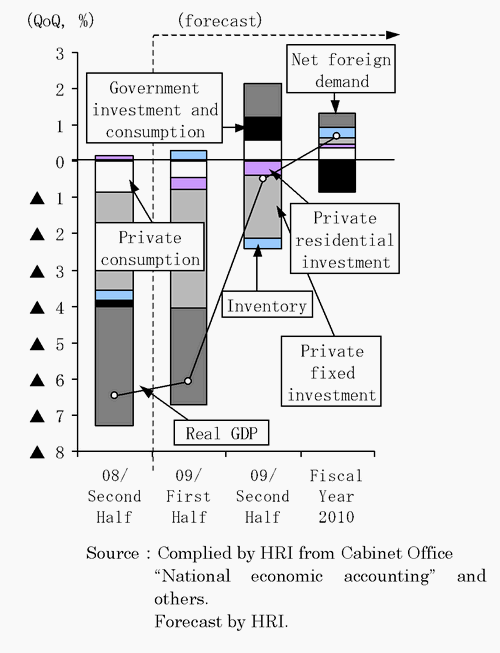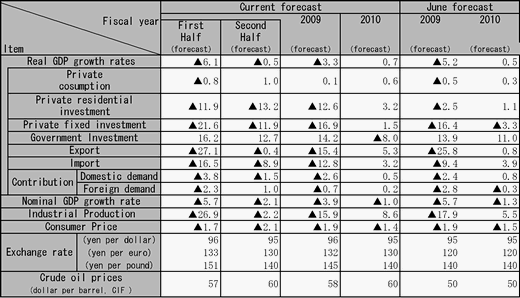Latest economic forecasts for Japan, the U.S., Europe, and China, etc
The sharp fall of the world economy finally de-accelerated from the rapid pace of the second quarter of this year. Industrial production started to recover in Asia; China’s real GDP growth rate in Q2 grew by 7.9% compared with the same quarter of the previous year. Annualized growth rates of real GDP during Q2 for Germany and Japan expanded by 1.3% and 3.7%, respectively, compared with the previous quarter. The US real GDP growth rate contracted by 1.0%, although the rate of decline slowed compared with the previous quarter.
Recent economic indicators are improving, but, they mainly rely on economic stimulus. Besides the daring monetary relaxation, the increase in expenditure caused by the car purchase subsidy and public investment positively affected many indicators. Exports to China improved due in part to the "4 trillion Yuan economic stimulus," such as subsidies for the purchase of home appliances. On the other hand, as to private demand, especially in developed countries, private consumption remains sluggish due to slack labor markets and income reduction. The economic recovery of the rest of the world is still fragile, relying heavily on economic stimulus.
The background of the fragile economy is that loan default rates continue to increase, and the credit crunch continues, even though financial institutions in the US and Europe are getting through the crisis. A tiny shock could make the global economy hit a second bottom. Therefore the strength of the recovery is extremely weak and deflationary pressures are strong. Even though the economy is forecast to grow, the recovery of labor and income is projected to take time, with recovery taking until the middle of 2010. During this period, world industrial structure will change dramatically.
The US real GDP growth rate is expected to turn positive in Q3 of 2009, compared to the previous quarter, shifting from a "rent and consume" economy to a "save and invest" economy. The growth rates of real GDP in 2009 and 2010 are forecast to contract by 2.8% and grow by 1.3%, respectively. Among Europe, Germany is projected to lead the recovery, however as a whole the EU is forecast to decline by 4.1% in 2009 and expand by 0.3% in 2010. On the other hand, China is expected to achieve 8% growth, the government goal for 2009. Domestic demand in India is robust. Therefore the global economic forecast was revised slightly upward, declining by 1.2% in 2009, and growing by 2.2% in 2010.
The Japanese economy barely hit bottom, and the Democratic Party won an overwhelming victory in the election of the House of Representatives on August 30. This is the first earnest political power shift since World War Two. The big policy conversion is expected to take place, and policies will shift in focus from corporations to households, such as subsidies for children. For the moment, the execution of some public projects is expected to stop which will affect the economy. Domestic demand will shift away from a public investment industry to a service industry for households. And if the approval of the Fiscal Year 2010 budget is delayed, the originally fragile economy may worsen, exposing the economy to the risk of a second bottoming out. The change of diplomacy and trade policies, and strong yen risks need to be carefully observed.
Another focal point is policy to combat global warming. The Democratic Party’s goal is to decrease green house gases 25% by 2020, which is less than 1990 levels (The Liberal Democratic Party’s goal is to reduce green house gases by 8%). This induces "green" demand, which has a positive effect on the environmental market, however the goal is so high that it might restrain economic growth.
As to the current economy, exports to China started to recover, and the economic stimulus has increased public projects, affecting the economy more than expected. Therefore the economic growth rate was revised slightly upward. However private demand stays weak, labor and income are still sluggish, and investment in plant and equipment are expected to steeply decrease. For the moment, the Japanese economy continues to rely on the stimulus. The N1H1 flu epidemic is also one of the negative factors. The real GDP growth rate during the whole FY 2009 is projected to contract by 3.3% compared to the previous FY (the growth rate of the first half and the second half of FY 2009 compared to the same period of the previous FY are projected to decline by 6.1% and grow by 0.5%, respectively.). In FY 2010, the growth rate is forecast to grow by 0.7%. Foreign exchange rate is forecast at 95 yen/ dollar and 130 yen / euro, and the oil price outlook is $60/barrel after the second half of FY 2009.



